Evaluation of Void Defects behind Tunnel Lining through GPR forward Simulation
Abstract
1. Introduction
- Establishing a GPR forward model and analyzing the variables (width, thickness, inflation, and water filling) affecting the void response mode.
- Calculating the response area of the voids by binarization method and confirming the applicability of GPR to estimate the void area.
- Providing a method of determining the center of voids location according to the response intensity.
2. Theoretical Background
3. Forward Simulation Based on FDTD
3.1. Establishment of Model
3.2. Parameters Determination
4. Analysis of Forward Simulation
4.1. Non-Void Lining
4.2. Influence of Void Width
4.3. Influence of Void Thickness
4.4. Influence of Water-Filled and Air-Filled Voids
4.5. Statistics of Void Response Area
4.6. Three-Dimensional forward Simulation of Void
5. Conclusions and Discussions
Author Contributions
Funding
Institutional Review Board Statement
Informed Consent Statement
Data Availability Statement
Conflicts of Interest
References
- He, B.G.; Liu, E.R.; Zhang, Z.Q.; Zhang, Y. Failure modes of highway tunnel with voids behind the lining roof. Tunn. Undergr. Space Technol. 2021, 117, 104147. [Google Scholar] [CrossRef]
- Saeidi, T.; Alhawari, A.R.H.; Almawgani, A.H.M.; Alsuwian, T.; Imran, M.A.; Abbasi, Q. High gain compact UWB antenna for ground penetrating radar detection and soil inspection. Sensors 2022, 22, 5183. [Google Scholar] [CrossRef]
- Birhane, F.N.; Choi, Y.T.; Lee, S.J. Development of condition assessment index of ballast track using ground-penetrating radar(gpr). Sensors 2021, 21, 6875. [Google Scholar] [CrossRef]
- Karsznia, K.R.; Onyszko, K.; Borkowska, S. Accuracy tests and precision assessment of localizing underground utilities using GPR detection. Sensors 2021, 21, 6765. [Google Scholar] [CrossRef]
- Colagrande, S.; Ranalli, D.; Tallini, M. GPR research on damaged road pavements built in cut and fill sections. Transp. Res. Proc. 2020, 45, 30–37. [Google Scholar] [CrossRef]
- Bai, H.; Sinfield, J.V. Improved background and clutter reduction for pipe detection under pavement using Ground Penetrating Radar (GPR). J. Appl. Geophy. 2020, 172, 103918. [Google Scholar] [CrossRef]
- Murín, I.; Neumann, M.; Brady, C.; Bátora, J.; Čapo, M.; Drozd, D. Application of magnetometry, georadar (GPR) and geoelectrical methods in archaeo-geophysical investigation of a Napoleonic battlefield with fortification at Pressburg (Bratislava, Slovakia). J. Appl. Geophy. 2021, 196, 104493. [Google Scholar] [CrossRef]
- Ortega-Ramírez, J.; Bano, M.; Villa Alvarado, L.A.; Medellín, M.D.; Rivero-Chong, R.; Motolinía-Temol, C.L. High-resolution 3-D GPR applied in the diagnostic of the detachment and cracks in pre-Hispanic mural paintings at “Templo Rojo”, Cacaxtla, Tlaxcala, Mexico. J. Cult. Herit. 2021, 50, 61–72. [Google Scholar] [CrossRef]
- Qin, H.; Zhang, D.; Tang, Y.; Wang, Y. Automatic recognition of tunnel lining elements from GPR images using deep convolutional networks with data augmentation. Autom. Constr. 2021, 130, 103830. [Google Scholar] [CrossRef]
- Qin, H.; Tang, Y.; Wang, Z.; Xie, X.; Zhang, D. Shield tunnel grouting layer estimation using sliding window probabilistic inversion of GPR data. Tunn. Undergr. Space Technol. 2021, 112, 103913. [Google Scholar] [CrossRef]
- Feng, D.; Wang, X.; Zhang, B. Specific evaluation of tunnel lining multi-defects by all-refined GPR simulation method using hybrid algorithm of FETD and FDTD. Constr Build Mater. 2018, 185, 220–229. [Google Scholar] [CrossRef]
- McCann, D.M.; Forde, M.C. Review of NDT methods in the assessment of concreteand masonry structures. NDT E Int. 2001, 34, 71–84. [Google Scholar] [CrossRef]
- Shaw, M.R.; Millard, S.G.; Molyneaux, T.C.K.; Taylor, M.J.; Bungey, J.H. Location of steel reinforcement in concrete using ground penetrating radar and neural networks. NDT E Int. 2004, 38, 203–212. [Google Scholar] [CrossRef]
- Gokhan, K.; Levent, E. Neural network based inspection of voids and karst conduits in hydro–electric power station tunnels using GPR. J. Appl. Geophy. 2018, 151, 194–204. [Google Scholar] [CrossRef]
- David, B.D. Computational Electromagnetics for RF and Microwave Engineering; Cambridge University Press: Cambridge, UK, 2010. [Google Scholar] [CrossRef]
- Yee, K. Numerical solution of initial boundary value problems involving Maxwell’s equations in isotropic media. IEEE. Trans. Antennas. Propag. 1966, 14, 302–307. [Google Scholar] [CrossRef]
- Annan, A.P. Ground Penetrating Radar Principles, Procedures and Applications; Sensors and Software Inc.: Mississauga, ON, Canada, 2003; pp. 278–286. [Google Scholar]
- Qin, H.; Xie, X.; Vrugt, J.A.; Zeng, K.; Hong, G. Underground structure defect detection and reconstruction using cross hole GPR and Bayesian waveform inversion. Autom. Constr. 2016, 68, 156–169. [Google Scholar] [CrossRef]
- Zhao, S.; Al-Qadi, I. Pavement drainage pipe condition assessment by GPR image reconstruction using FDTD modeling. Constr. Build. Mater. 2017, 154, 1283–1293. [Google Scholar] [CrossRef]
- Li, Y.; Zhao, Z.; Xu, W.; Liu, Z.; Wang, X. An effective FDTD model for GPR to detect the material of hard objects buried in tillage soil layer. Soil. Tillage. Res. 2019, 195, 104353. [Google Scholar] [CrossRef]
- Lu, Y.; Peng, S.; Cui, X.; Li, D.; Wang, K.; Xing, Z. 3D FDTD anisotropic and dispersive modeling for GPR using rotated staggered grid method. Comput. Geo. 2020, 136, 104397. [Google Scholar] [CrossRef]
- Lin, C.; Wang, X.; Li, Y.; Zhang, F.; Xu, Z.; Du, Y. Forward modelling and GPR imaging in leakage detection and grouting evaluation in tunnel lining. KSCE J. Civ. Eng. 2020, 24, 278–294. [Google Scholar] [CrossRef]
- Lv, Y.; Wang, H.; Gong, J. Application of GPR reverse time migration in tunnel lining cavity imaging. Appl. Geophys. 2020, 17, 277–284. [Google Scholar] [CrossRef]
- Warren, C.; Giannopoulos, A.; Giannakis, I. GprMax: Open source software to simulate electromagnetic wave propagation for Ground Penetrating Radar. Comput. Phys. Commun. 2016, 209, 163–170. [Google Scholar] [CrossRef]
- Giannakis, I.; Giannopoulos, A.; Warren, C. A realistic FDTD numerical modeling framework of ground penetrating radar for landmine detection. IEEE J. Sel. Top. Appl. Earth Observ. Remote Sens. 2015, 9, 37–51. [Google Scholar] [CrossRef]
- Giannopoulos, A. Modelling ground penetrating radar by GprMax. Constr. Build. Mater. 2005, 19, 755–762. [Google Scholar] [CrossRef]
- Ristić, A.; Bugarinović, Ž.; Vrtunski, M.; Govedarica, M. Point coordinates extraction from localized hyperbolic reflections in GPR data. J. Appl. Geophy. 2017, 144, 1–17. [Google Scholar] [CrossRef]
- Angelis, D.; Tsourlos, P.; Tsokas, G.; Vargemezis, G.; Zacharopoulou, G.; Power, C. Combined application of GPR and ERT for the assessment of a wall structure at the Heptapyrgion fortress (Thessaloniki, Greece). J. Appl. Geophy. 2018, 152, 208–220. [Google Scholar] [CrossRef]
- Hu, X.; He, C.; Feng, K.; Liu, S.; Walton, G. Effects of polypyrrole coated rebar on corrosion behavior of tunnel lining with the combination effect of sustained loading and pre-existing cracks when exposed to chlorides. Constr. Build. Mater. 2019, 221, 318–331. [Google Scholar] [CrossRef]
- Zhang, Y.; Wang, M.; Yu, L.; Guo, X.; Wang, Z.; Li, C. Experimental and numerical research on the influence of steel arch frame corrosion on security of supporting system in subsea tunnel. Tunn. Undergr. Space. Technol. 2022, 120, 104253. [Google Scholar] [CrossRef]
- Giannopoulos, A. Unsplit implementation of higher order PMLs. IEEE Trans. Antennas Propag. 2011, 60, 1479–1485. [Google Scholar] [CrossRef]
- Xiang, L.; Zhou, H.L.; Shu, Z.; Tan, S.H.; Liang, G.Q.; Zhu, J. GPR evaluation of the Damaoshan highway tunnel: A case study. NDT E Int. 2013, 59, 68–76. [Google Scholar] [CrossRef]
- Chang, S.B.; Zhang, S.M. Engineering Geology Manual, 4th ed.; China Architecture and Building Press: Beijing, China, 2006. (In Chinese) [Google Scholar]
- Zhang, F.; Xie, X.; Huang, H. Application of ground penetrating radar in grouting evaluation for shield tunnel construction. Tunn.Undergr. Space Technol. 2010, 25, 99–107. [Google Scholar] [CrossRef]
- Xie, X.; Zeng, C.; Wang, Z. GPR signal enhancement using band-pass and K–L filtering: A case study for the evaluation of groutin a shielded tunnel. J. Geophys. Eng. 2013, 10, 034003. [Google Scholar] [CrossRef]
- Xiao, M.; Chen, C.; Su, Z. The calculation method of equivalent dielectric constant of multi-layer underground media. Geophy. Geoche. Explor. 2013, 37, 368–372. [Google Scholar] [CrossRef]
- DB61/T 1289-2019; Technical Regulation for Geological Radar Detection of Highway Tunnel. 1st ed, Administration for Market Regulation of Guizhou Province: Guizhou, China, 2019; p. 5.
- Sandmeier, K.J. Reflexw, version 6.0.; Sandmeier Scientific Software: Karlsruhe, Germany, 2011. [Google Scholar]
- Luo, T.X.H.; Lai, W.W.L.; Giannopoulos, A. Forward modelling on GPR responses of subsurface air voids. Tunn. Undergr. Space. Technol. 2020, 103, 103521. [Google Scholar] [CrossRef]

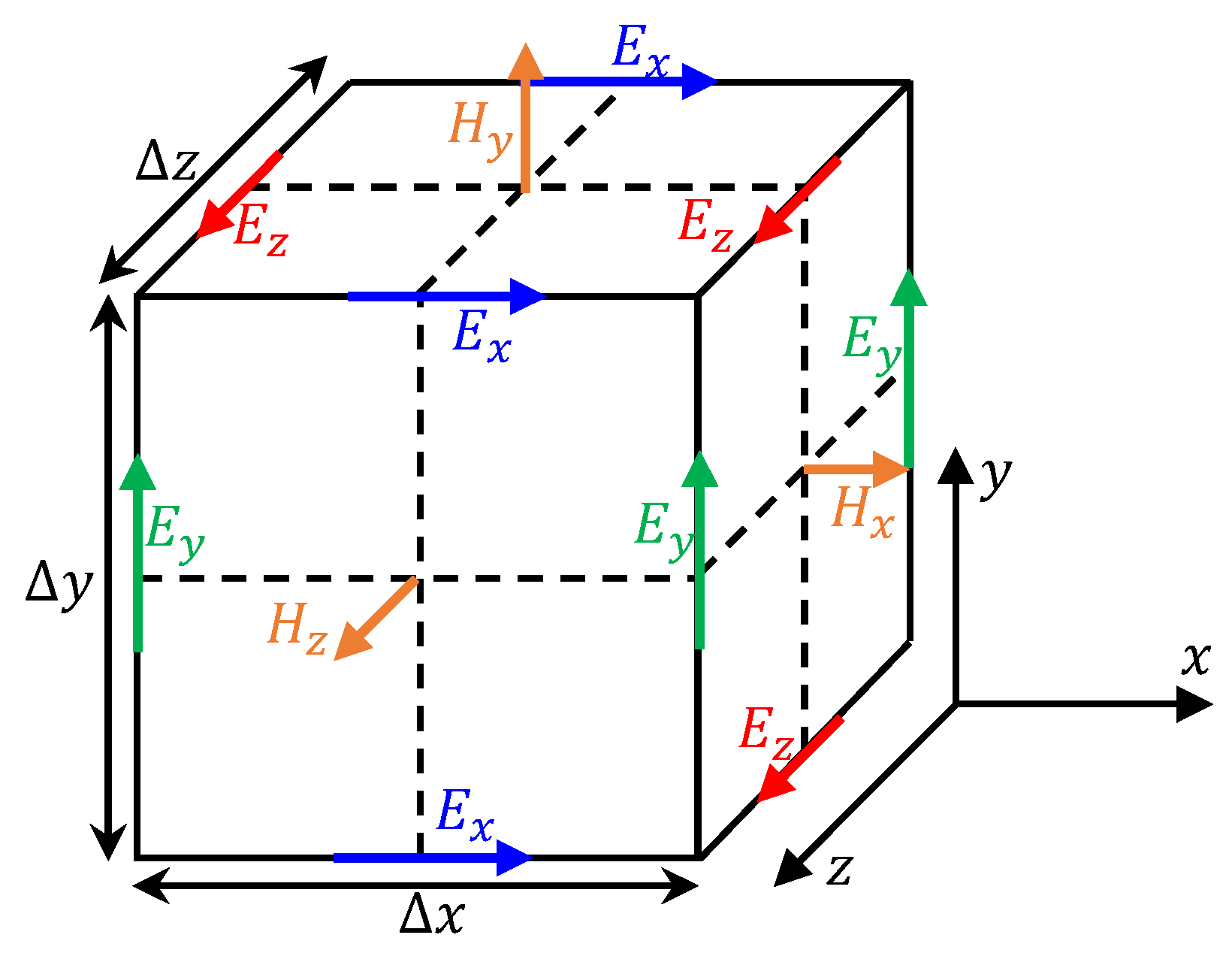


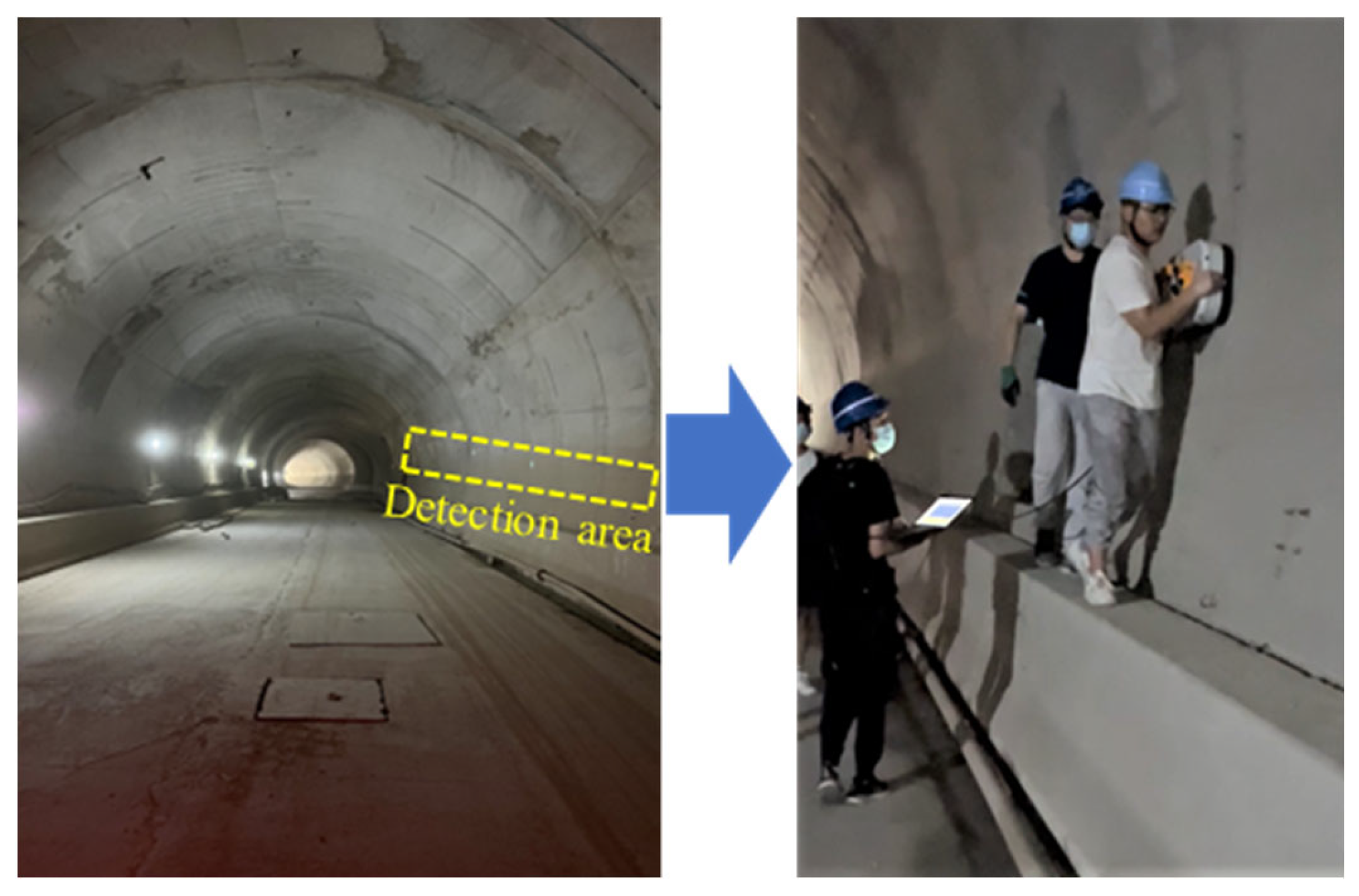

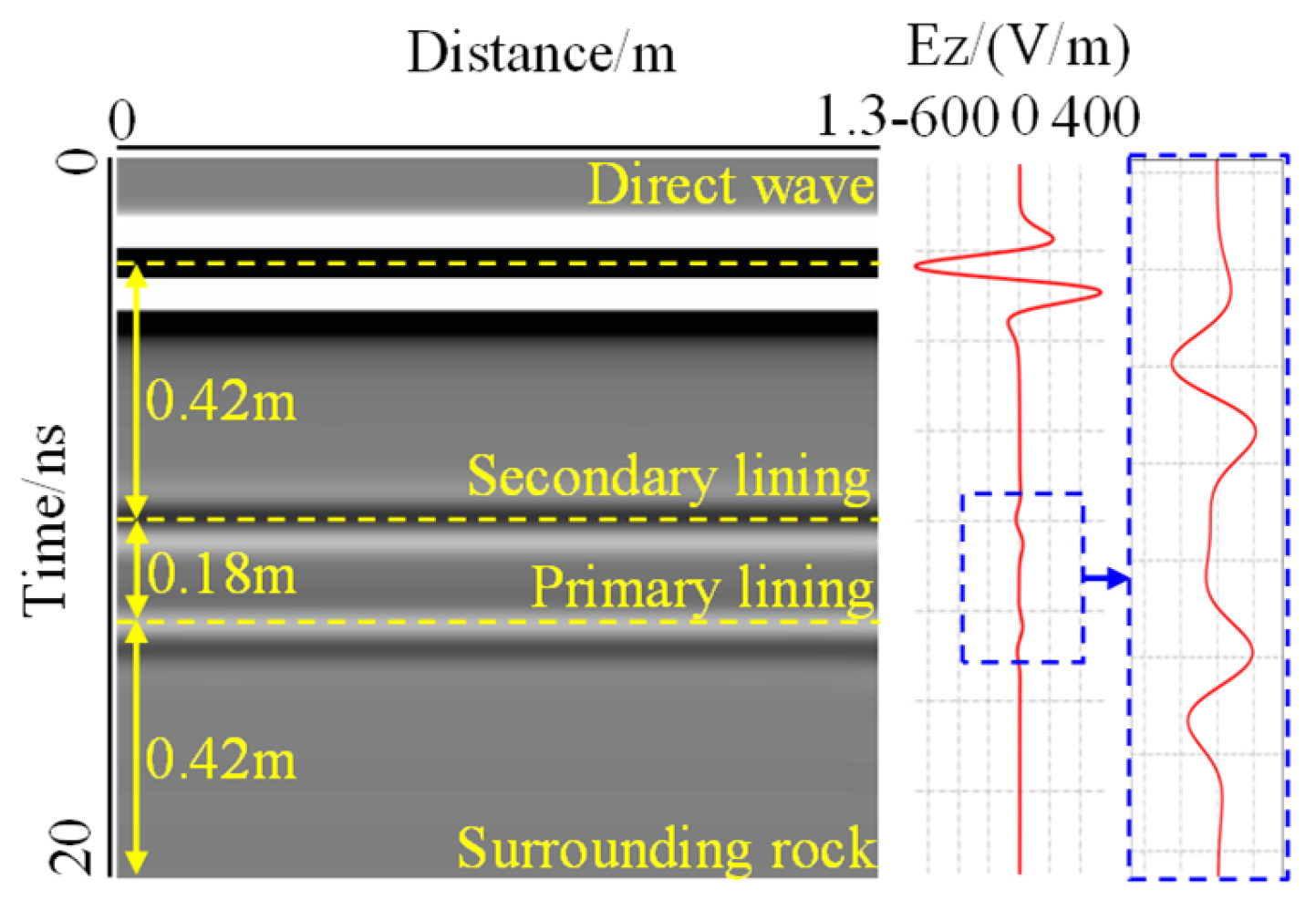


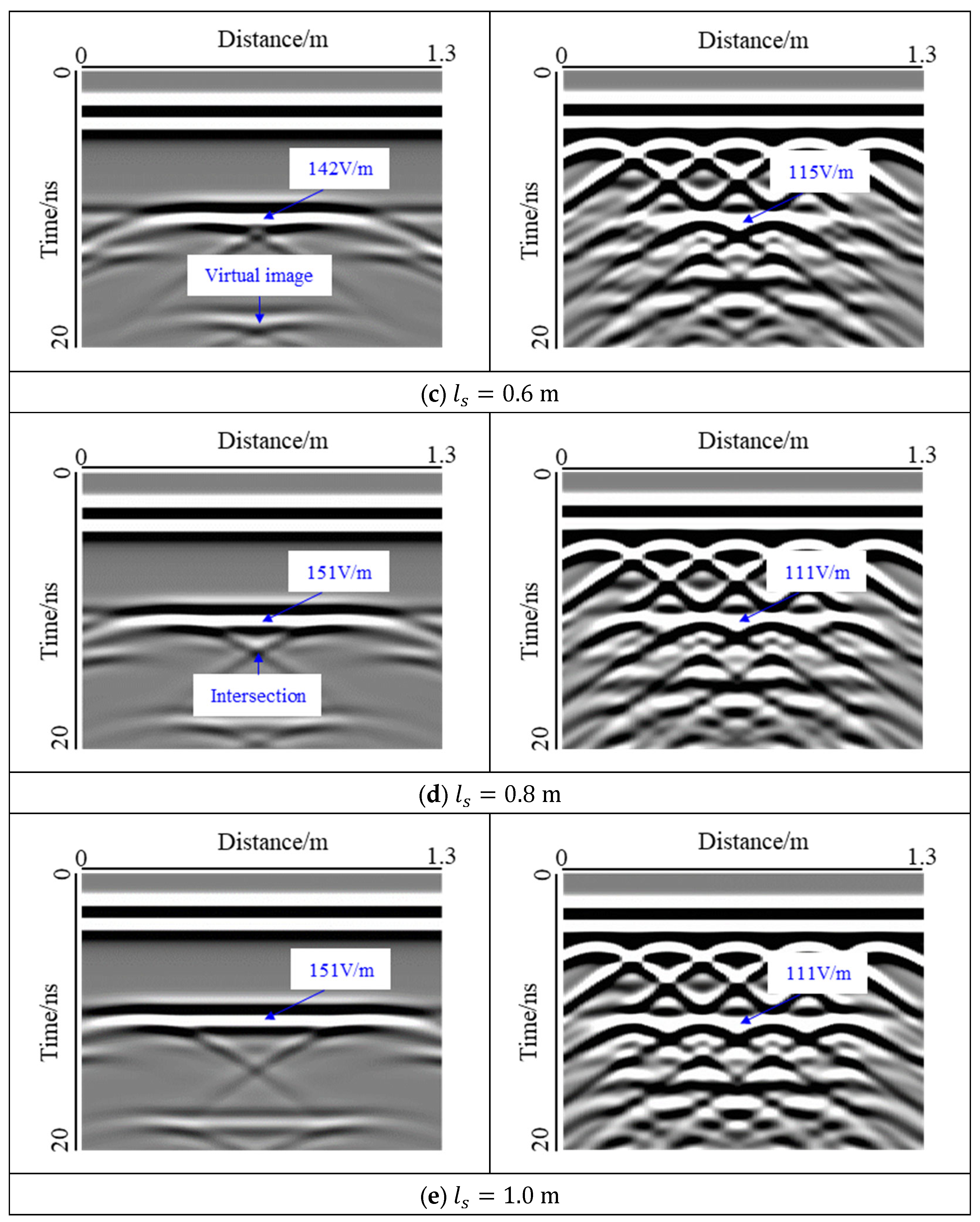
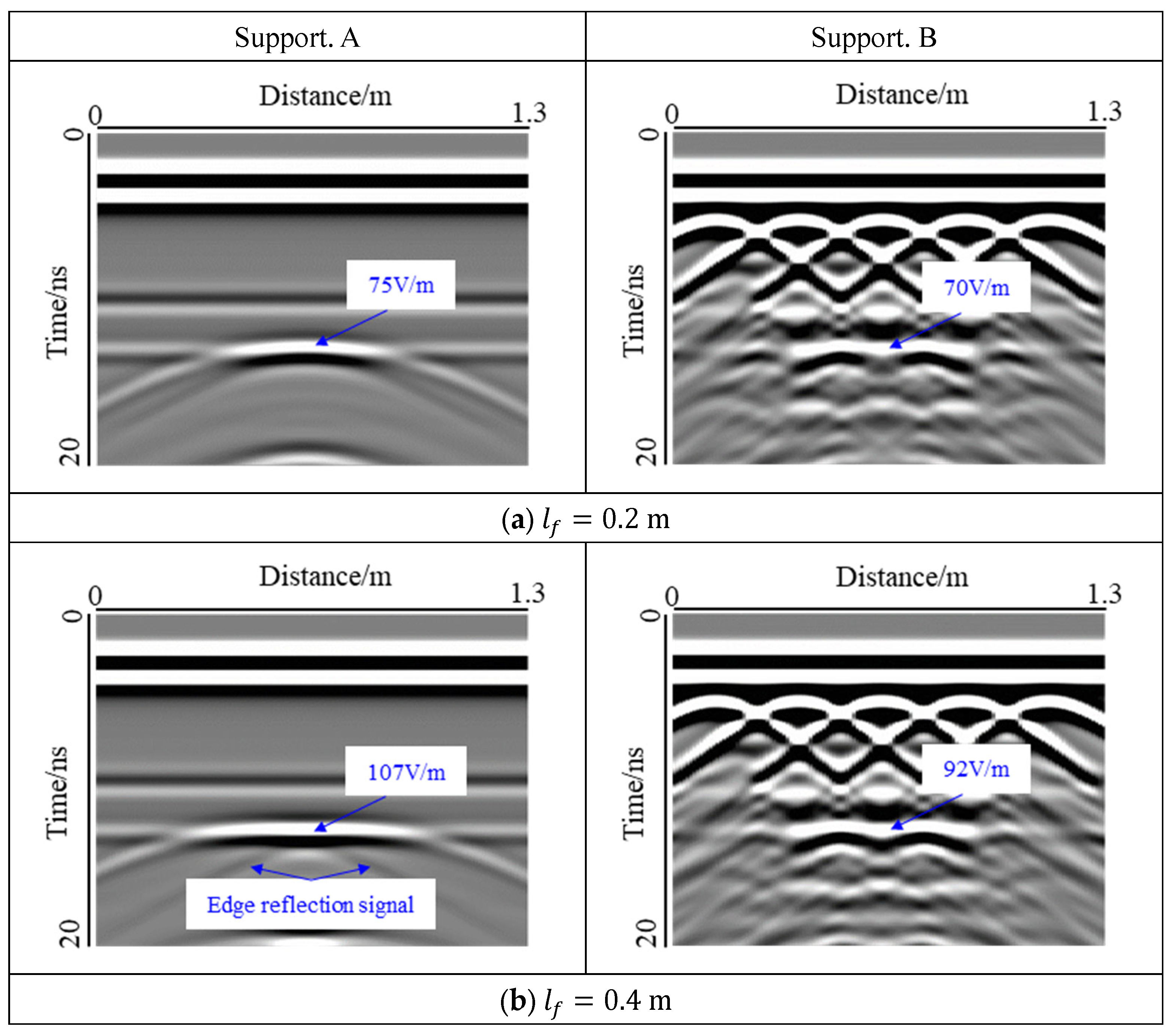
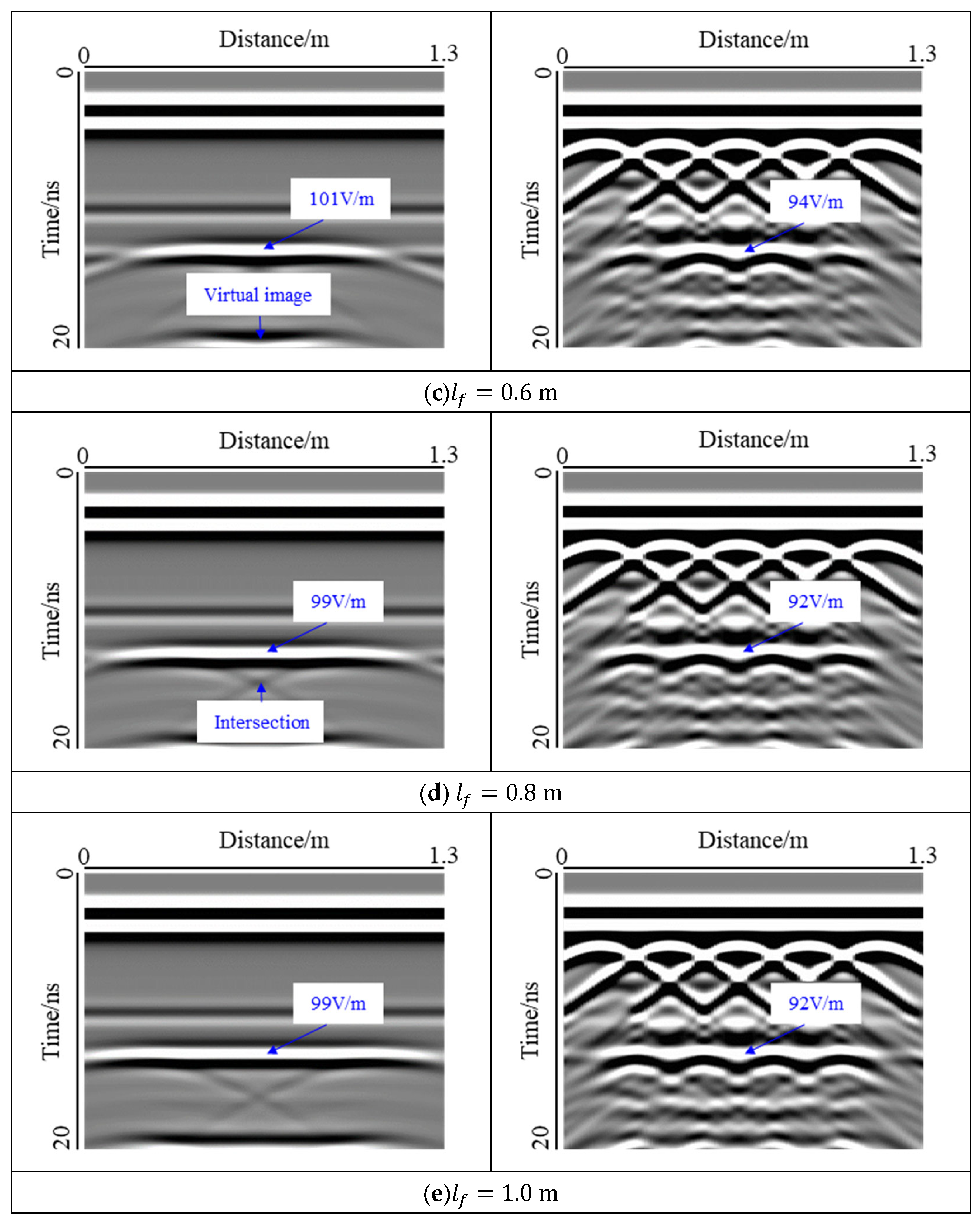


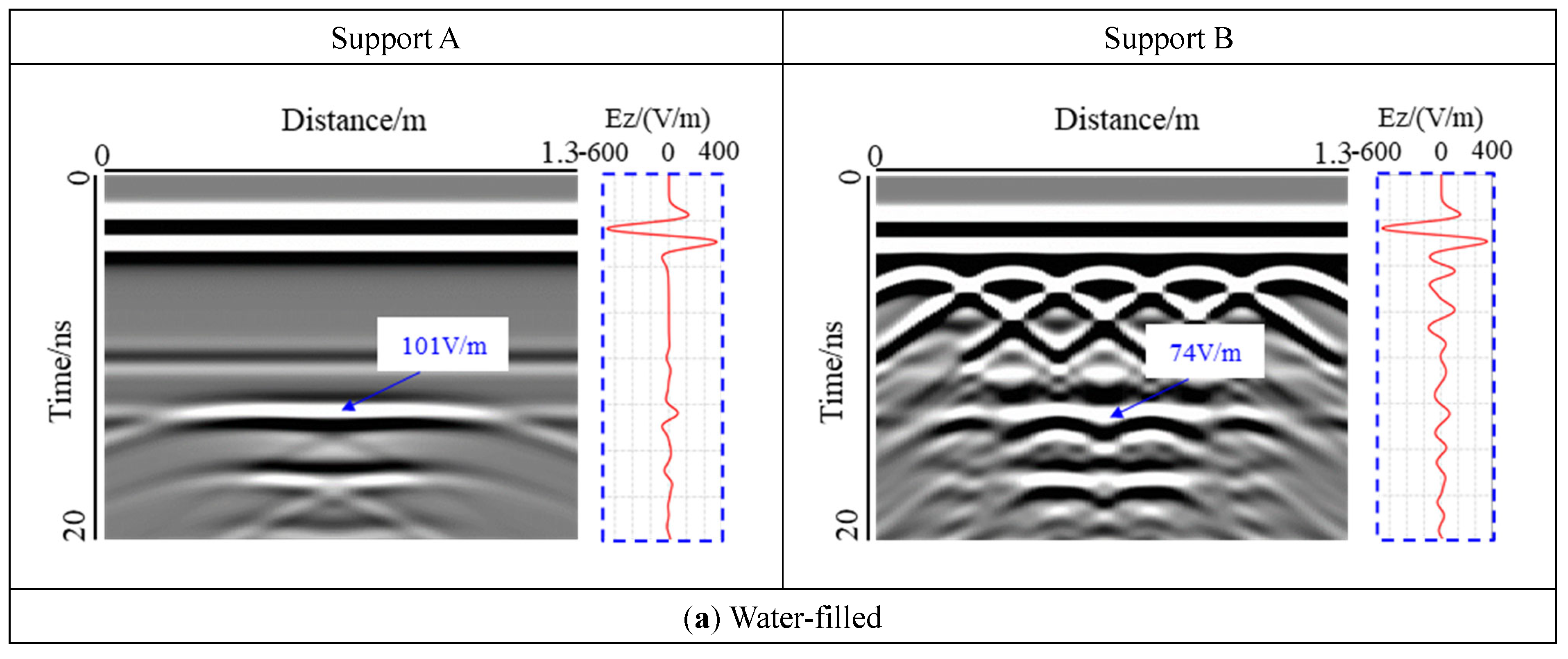
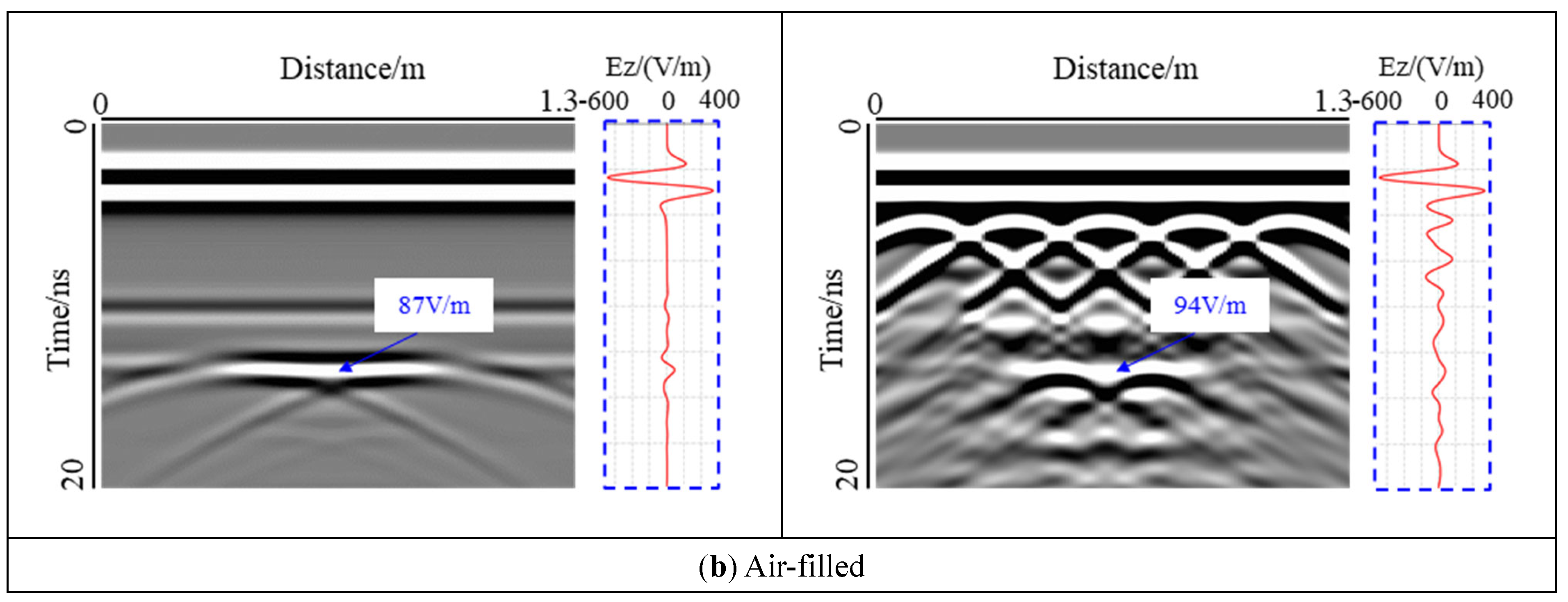
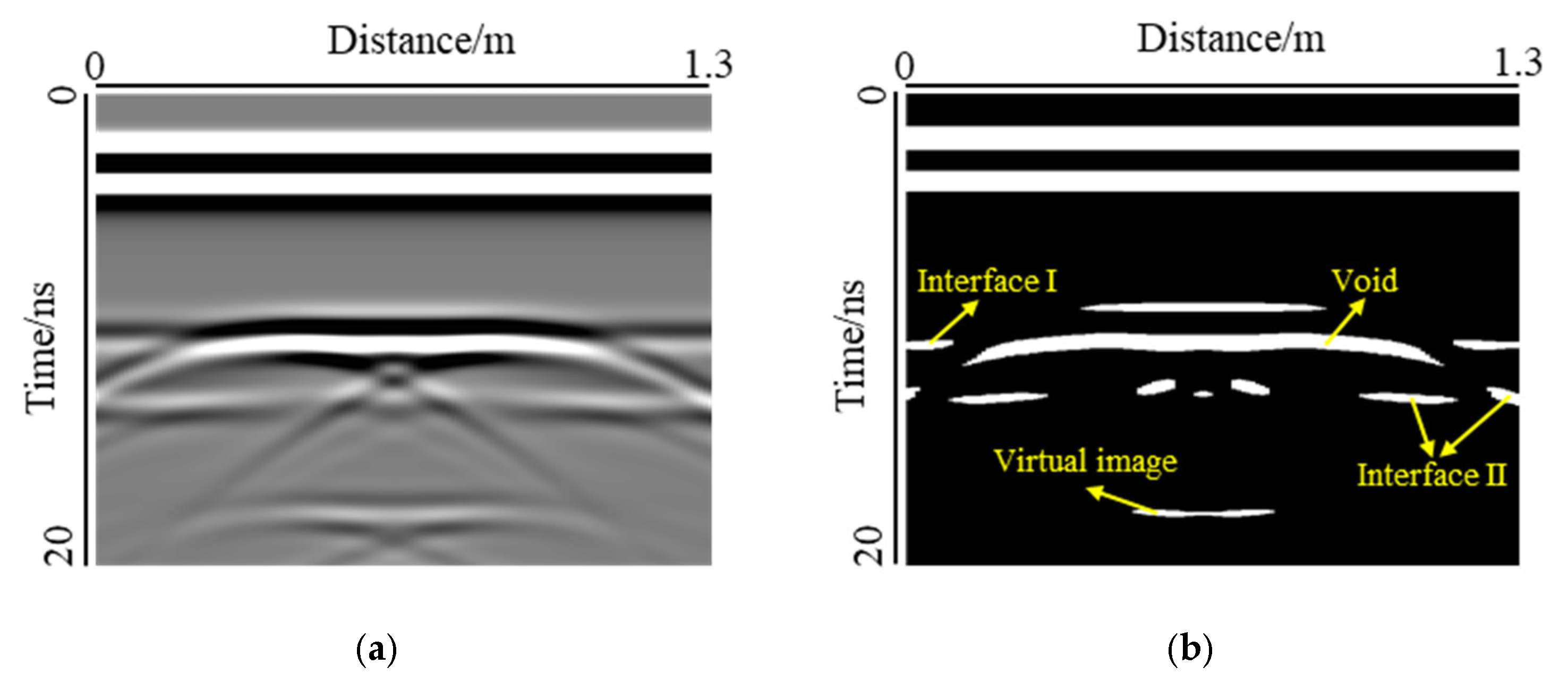


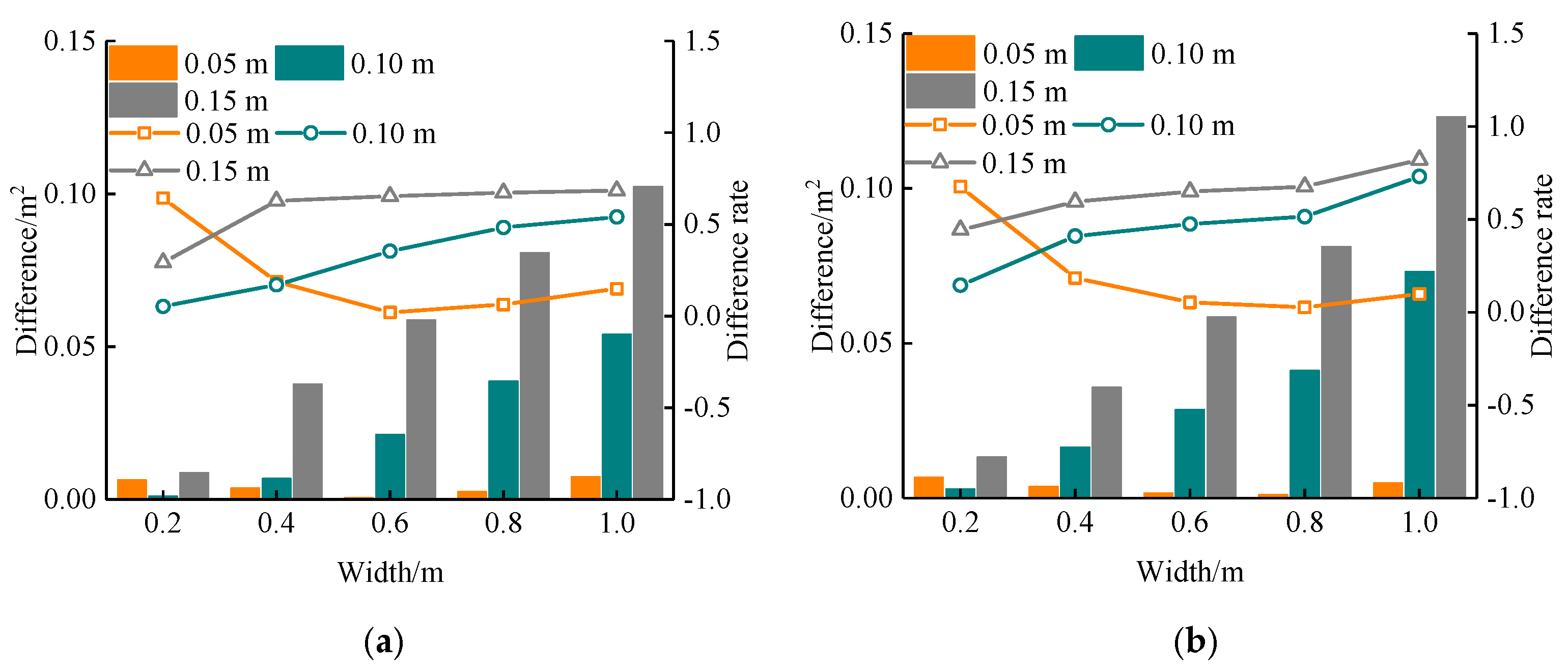


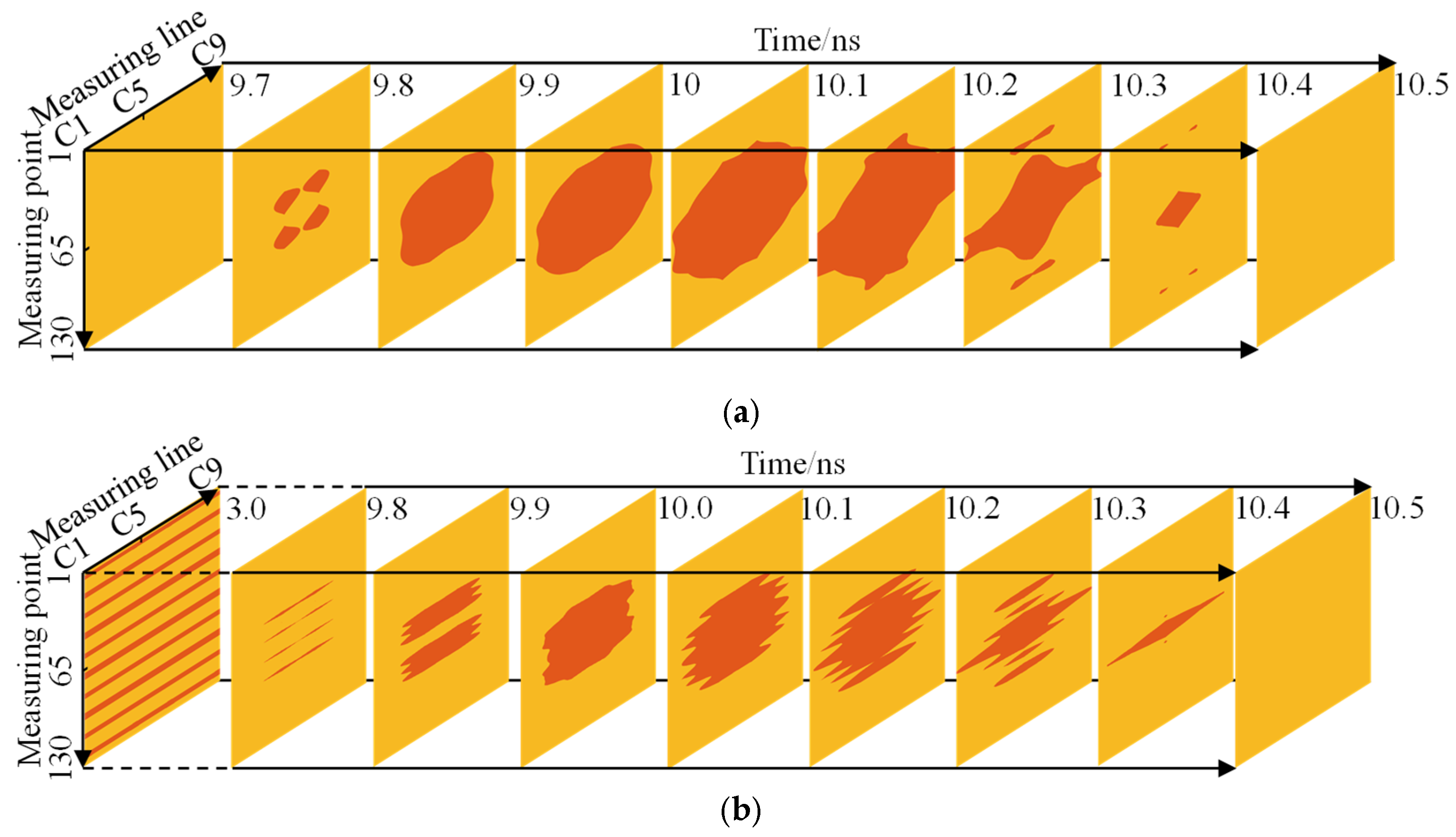
| Grid Size | ∆x (m) | ∆y (m) | ∆z (m) | |
| 0.005 | 0.005 | 0.005 | ||
| GPR | Frequency (MHz) | Excitation | Spatial step (m) | Time window (ns) |
| 500 | Ricker | 0.01 | 20 | |
| Medium | Relative Permittivity | Conductivity (mS/m) | Equivalent relative permittivity | Equivalent velocity (m/ns) |
| Second lining | 7.5 | 0.005 | 6.19 | 0.12 |
| Primary lining | 5.0 | 0.005 | ||
| Rock | 8.0 | 0.001 | ||
| Water | 81.0 | 0.03 |
Publisher’s Note: MDPI stays neutral with regard to jurisdictional claims in published maps and institutional affiliations. |
© 2022 by the authors. Licensee MDPI, Basel, Switzerland. This article is an open access article distributed under the terms and conditions of the Creative Commons Attribution (CC BY) license (https://creativecommons.org/licenses/by/4.0/).
Share and Cite
Wu, X.; Bao, X.; Shen, J.; Chen, X.; Cui, H. Evaluation of Void Defects behind Tunnel Lining through GPR forward Simulation. Sensors 2022, 22, 9702. https://doi.org/10.3390/s22249702
Wu X, Bao X, Shen J, Chen X, Cui H. Evaluation of Void Defects behind Tunnel Lining through GPR forward Simulation. Sensors. 2022; 22(24):9702. https://doi.org/10.3390/s22249702
Chicago/Turabian StyleWu, Xianlong, Xiaohua Bao, Jun Shen, Xiangsheng Chen, and Hongzhi Cui. 2022. "Evaluation of Void Defects behind Tunnel Lining through GPR forward Simulation" Sensors 22, no. 24: 9702. https://doi.org/10.3390/s22249702
APA StyleWu, X., Bao, X., Shen, J., Chen, X., & Cui, H. (2022). Evaluation of Void Defects behind Tunnel Lining through GPR forward Simulation. Sensors, 22(24), 9702. https://doi.org/10.3390/s22249702







